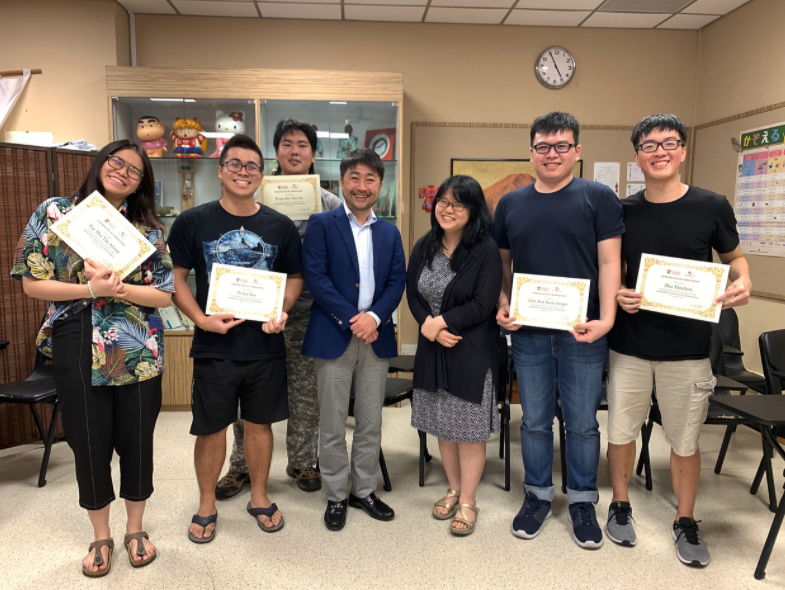
Home » Success Story – 14047
COMPANY:
Light aircraft manufacturer
My major is aviation engineering, but I am also interested in mechanical engineering classes. He is an intern and has experience in designing mechanical lines at SOLIDWORKS. His research is on the mechanical behavior of metal lattices with different topologies under quasi-static compression by laminated modeling, under the guidance of professors and doctors. He is cheerful and energetic, and has a strong desire to complete conversations and descriptions in Japanese.
Profile
COUNTRY / REGION
Singapore
SEX
Female
UNIVERSITY
Nanyang Technological University, Singapore
SPECIALIZATION
Aerospace
ACADEMIC LEVEL
Bachelor
MESSAGE
When I got a job in Japan, I participated in the Japanese language no class program of Nanyang Technological University provided by ASIA to JAPAN (AtoJ). After that, in the process of getting a job in Japan, creating a resume in Japanese, Skype interview with ASIA to JAPAN for desired occupation and industry, self-appeal, how to create a PR video, Japanese style interview correspondence Support will be provided. In the mock interview with ASIA to JAPAN mentor, I was able to prepare for the day of the interview by not only preparing for the day but also taking measures for questions related to software technology.
The initial interview to get a job offer from a leading Japanese venture company was so quick that I was able to calmly work on my final year project and exams. Skype interviews are often more difficult than face-to-face interviews, so it took several days to prepare, but in the actual interview, I was able to calm down and respond to the interview in a coherent manner. The interview was conducted in English, so it was easy to convey my opinions and thoughts.
When I got the offer, I had anxiety and many questions about working in another country. By answering many questions through all the processes, I was able to resolve my anxiety and doubts. Working with Japanese people and many foreign employees at a cutting-edge venture company in Japan led to learning not only programming skills but also communication skills and working styles.
I have already joined the company and worked in Japan, but my experience so far has been extraordinary (irregular) to say the least. It’s been a month and a half since I moved from Singapore to Japan. During that time, the coronavirus was prevalent and due to an abnormal situation, all processes had to be carried out promptly after coming to Japan. Three days after arriving in Japan, I started working, and in the midst of a lot of confusion, I also went through the procedures for finding a place to live and the government office for living.
The initial interview to get a job offer from a leading Japanese venture company was so quick that I was able to calmly work on my final year project and exams. Skype interviews are often more difficult than face-to-face interviews, so it took several days to prepare, but in the actual interview, I was able to calm down and respond to the interview in a coherent manner. The interview was conducted in English, so it was easy to convey my opinions and thoughts.
When I got the offer, I had anxiety and many questions about working in another country. By answering many questions through all the processes, I was able to resolve my anxiety and doubts. Working with Japanese people and many foreign employees at a cutting-edge venture company in Japan led to learning not only programming skills but also communication skills and working styles.
I have already joined the company and worked in Japan, but my experience so far has been extraordinary (irregular) to say the least. It’s been a month and a half since I moved from Singapore to Japan. During that time, the coronavirus was prevalent and due to an abnormal situation, all processes had to be carried out promptly after coming to Japan. Three days after arriving in Japan, I started working, and in the midst of a lot of confusion, I also went through the procedures for finding a place to live and the government office for living.

FINAL YEAR PROJECT
タイトル:
Mechanical behaviour of unconstrained metal lattices with varying topologies by additive manufacturing under quasi-static compression(積層造形による異なるトポロジーの金属格子を準静的圧縮下での機械的挙動)
この研究は担任の先生とPhDの先輩のテーマの一部をFinal Year Projectとして1人で2019.1~2019.12まで行います。
① 目的:
シミュレーションした構造の機械的性質の正確度を3Dプリント(レーザー溶融法(SLM))した構造と比較します.結果が似ていれば、シミュレーションした構造が実行可能なオプションです.それから、製造前に構造の機械的性質を知ったので、コストをさげることができます.
次の3つを証明します。
A.金属格子構造のユニットセルトポロジとユニットセルの直径対長さ比(diameter to length ratio)を変更したので、機械的性質への影響は何ですか。
B.ソフトを「ABAQUS/ Standard」使えた、Finite Element Analysisのシミュレーション行った金属構造と実際にプリントした金属構造の機械的性質を比べます。
C.「ABAQUS/ Standard」と「ABAQUS/ Explicit」にFinite Element Analysisのシミュレーションを行ったので、結果が何処で違うか。
② 実施内容
A.文献調査
i.有限要素解析(Finite Element Analysis)や付加製造技術(レーザー溶融法, Selective Laser Melting)や金属格子構造のユニットセルトポロジなどについての学術雑誌を読みました。
B.対象の決定
i.担任先生とPhDの先輩が相談し、BCCとFCCのユニットセルトポロジで出来た金属構造を調べることに決まりました。
C.シミュレーションモデルの作成
i.Computer -Aided Engineering (CAE)のソフトの「ABAQUS/ Standard」を自分で習いました.SIMULIAのガイドとチュートリアルが使えた。
ii.そして、「ABAQUS/ Standard」でBCCとFCCのユニットセルトポロジで出来ていた構造のモデル(Beam Element Model)を作りました.
iii.次、各ユニットセルの直径対長さ比(diameter to length ratio)が変更したモデル(Beam Element Model)も作りました.
D.シミュレーションの実施
i.BCCとFCCのユニットセルトポロジで出来ていた構造の機械的性質は「ABAQUS/ Standard」が使え、Finite Element Analysisを行いました.構造が圧縮のシミュレーションをしました.
E.シミュレーション結果の解析
i.力―位置のグラフ(force-displacement curve)や圧縮のアニメーションなど の作成 。
ーー(ここまでが、現在の進捗です.そこから、来学期に続けていく.)ーー
ii.構造の相当塑性ひずみ(equivalent plastic strain)や応力三軸度(stress triaxiality)など の測定
F.3Dプリントの作成と機械的性質の測定
i.3Dプリント(レーザー溶融法)作った実際の金属構造をプリントして、プリントした金属構造はInstronを使って、圧縮します.すると構造実際の機械的性質の結果を取ります.
G.シミュレーションと実験の比較
i.シミュレーションと実際にプリントした機械的性質の結果を比べます.力―位置のグラフ(force-displacement curve)や応力-ひずみ曲線(stress-strain curve)などを比べます.
ii.シミュレーションと実験の差異をハイライトして、理由を説明します.
③ いままで行ってきての感想
このプロジェクトが一人でするので、たくさんの試行錯誤をしました.期待どおりの結果が得られた時に満足します.
Mechanical behaviour of unconstrained metal lattices with varying topologies by additive manufacturing under quasi-static compression(積層造形による異なるトポロジーの金属格子を準静的圧縮下での機械的挙動)
この研究は担任の先生とPhDの先輩のテーマの一部をFinal Year Projectとして1人で2019.1~2019.12まで行います。
① 目的:
シミュレーションした構造の機械的性質の正確度を3Dプリント(レーザー溶融法(SLM))した構造と比較します.結果が似ていれば、シミュレーションした構造が実行可能なオプションです.それから、製造前に構造の機械的性質を知ったので、コストをさげることができます.
次の3つを証明します。
A.金属格子構造のユニットセルトポロジとユニットセルの直径対長さ比(diameter to length ratio)を変更したので、機械的性質への影響は何ですか。
B.ソフトを「ABAQUS/ Standard」使えた、Finite Element Analysisのシミュレーション行った金属構造と実際にプリントした金属構造の機械的性質を比べます。
C.「ABAQUS/ Standard」と「ABAQUS/ Explicit」にFinite Element Analysisのシミュレーションを行ったので、結果が何処で違うか。
② 実施内容
A.文献調査
i.有限要素解析(Finite Element Analysis)や付加製造技術(レーザー溶融法, Selective Laser Melting)や金属格子構造のユニットセルトポロジなどについての学術雑誌を読みました。
B.対象の決定
i.担任先生とPhDの先輩が相談し、BCCとFCCのユニットセルトポロジで出来た金属構造を調べることに決まりました。
C.シミュレーションモデルの作成
i.Computer -Aided Engineering (CAE)のソフトの「ABAQUS/ Standard」を自分で習いました.SIMULIAのガイドとチュートリアルが使えた。
ii.そして、「ABAQUS/ Standard」でBCCとFCCのユニットセルトポロジで出来ていた構造のモデル(Beam Element Model)を作りました.
iii.次、各ユニットセルの直径対長さ比(diameter to length ratio)が変更したモデル(Beam Element Model)も作りました.
D.シミュレーションの実施
i.BCCとFCCのユニットセルトポロジで出来ていた構造の機械的性質は「ABAQUS/ Standard」が使え、Finite Element Analysisを行いました.構造が圧縮のシミュレーションをしました.
E.シミュレーション結果の解析
i.力―位置のグラフ(force-displacement curve)や圧縮のアニメーションなど の作成 。
ーー(ここまでが、現在の進捗です.そこから、来学期に続けていく.)ーー
ii.構造の相当塑性ひずみ(equivalent plastic strain)や応力三軸度(stress triaxiality)など の測定
F.3Dプリントの作成と機械的性質の測定
i.3Dプリント(レーザー溶融法)作った実際の金属構造をプリントして、プリントした金属構造はInstronを使って、圧縮します.すると構造実際の機械的性質の結果を取ります.
G.シミュレーションと実験の比較
i.シミュレーションと実際にプリントした機械的性質の結果を比べます.力―位置のグラフ(force-displacement curve)や応力-ひずみ曲線(stress-strain curve)などを比べます.
ii.シミュレーションと実験の差異をハイライトして、理由を説明します.
③ いままで行ってきての感想
このプロジェクトが一人でするので、たくさんの試行錯誤をしました.期待どおりの結果が得られた時に満足します.




